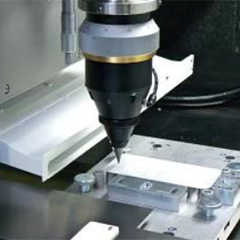Reutlingen, 5th November, 2014. High-tech mechanical engineering for the future’s growth markets: Electronic Components, Electronic Devices, Solar, and Energy Storage – these are the business segments of Manz. Our expertise is based upon six core technologies: Automation, Metrology, Printing, Laser Processing, Wet Chemical Processing and Vacuum Coating. Today: Our laser expertise as shown by a new laser cutting technology Manz has developed for cutting sapphire glass for displays.
Sapphire is superior to chemical strengthened glass, when it comes to cover glasses that are scratch- and impact-resistant, yet still flexible. It has long been used for watches, as cover or filter glass for camera lenses, and increasingly also for cellphone displays. Thanks to laser processing, displays now can be produced profitably from this extremely brittle material.
For this, Manz has developed two processes with different strengths, depending on the customer need: “Thermal” laser cutting with short laser pulses in the microsecond range, and removal as “cold” ablation of sapphire substrate using ultra-short pulse lasers with pulse durations of a few picoseconds. The latter offers higher-quality cutting edges but are also more expensive than the up to 300-watt fiber lasers that are needed for “thermal” laser cutting of sapphire.
“Thermal” laser cutting is suitable for cutting the outer contours of cover glasses as well as for cutting inner contours, e.g. holes for cameras, LEDs, or speakers. Cutting in this context is a melting process: The glass substrate is melted by introducing energy to the interface. The melted material is blown out of the interaction zone with relatively high pressure. This process results in neither micro-cracking nor chipping.
During “cold” ablation with a picosecond laser, the sapphire glass to be cut is not melted, but vaporized using an extremely short pulse duration and high peak pulse power associated with it. The quality of the cutting edge is even better than with thermal laser cutting, and the edge is smoother. But besides the better edge quality, ultra-short pulse lasers have additional advantages that quickly make them worth the higher price: More than just right-angle edges can be cut. For example, 10-degree tapering is possible, and the edge can be chamfered as well. Both improve the break resistance of the finished display.
You can read a detailed description of Manz’s two new laser cutting processes for sapphire glass in the current issue of Laser Magazin 3/2014 from the renowned magazine publisher Hightech Publications.
http://www.laser-magazin.de/dateien/inhalt.pdf
A video about Manz’s laser process technology expertise you can find here:
http://www.manz.com/de/media/downloads/videos/laser-technologies-65


























